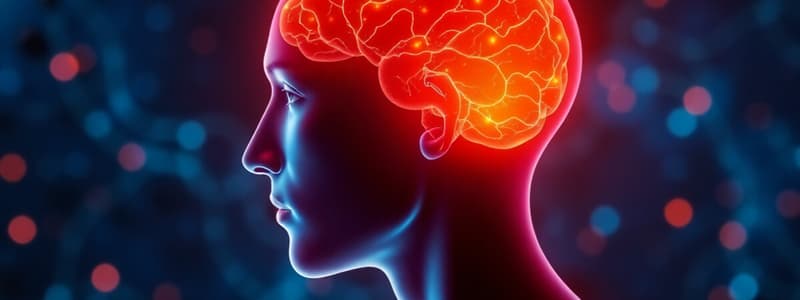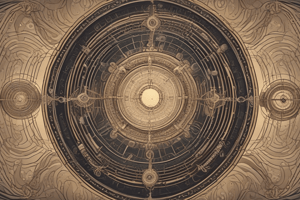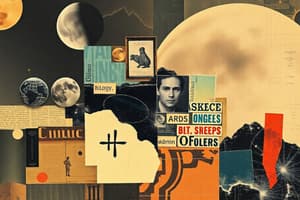Podcast
Questions and Answers
The suprachiasmatic nucleus (SCN) receives direct inputs from the geniculo-hypothalamic pathway via glutamate.
The suprachiasmatic nucleus (SCN) receives direct inputs from the geniculo-hypothalamic pathway via glutamate.
False (B)
Melatonin plays a role in entraining the suprachiasmatic nucleus (SCN) by modulating intracellular pathways.
Melatonin plays a role in entraining the suprachiasmatic nucleus (SCN) by modulating intracellular pathways.
True (A)
The suprachiasmatic nucleus (SCN) directly controls the release of Parathyroid Hormone (PTH).
The suprachiasmatic nucleus (SCN) directly controls the release of Parathyroid Hormone (PTH).
False (B)
The tuberal and posterior hypothalamus primarily influence the autonomic nervous system.
The tuberal and posterior hypothalamus primarily influence the autonomic nervous system.
Short-term memory and cognitive performance do not exhibit circadian oscillations.
Short-term memory and cognitive performance do not exhibit circadian oscillations.
The raphe-hypothalamic tract transmits norepinephrine to the SCN.
The raphe-hypothalamic tract transmits norepinephrine to the SCN.
The paraventricular hypothalamic nucleus is not involved in HPA axis regulation.
The paraventricular hypothalamic nucleus is not involved in HPA axis regulation.
Body temperature, blood pressure, and heart rate remain constant throughout the day since they are expected to remain the same.
Body temperature, blood pressure, and heart rate remain constant throughout the day since they are expected to remain the same.
The brain relies on only one parameter to entrain the circadian rhythm.
The brain relies on only one parameter to entrain the circadian rhythm.
Retinal ganglion cells respond primarily to the total amount of light.
Retinal ganglion cells respond primarily to the total amount of light.
Only photic information is relevant for circadian entrainment.
Only photic information is relevant for circadian entrainment.
Temperature signals for non-photic entrainment are available only from the skin.
Temperature signals for non-photic entrainment are available only from the skin.
Physical activity is solely a consequence of the sleep-wake cycle and can be easily chosen or avoided
Physical activity is solely a consequence of the sleep-wake cycle and can be easily chosen or avoided
The suprachiasmatic nucleus receives indirect information through the lateral geniculate nucleus.
The suprachiasmatic nucleus receives indirect information through the lateral geniculate nucleus.
The pineal gland produces melatonin, which is also known as the 4th eye.
The pineal gland produces melatonin, which is also known as the 4th eye.
The suprachiasmatic nucleus receives direct information from the inter-geniculate leaflet.
The suprachiasmatic nucleus receives direct information from the inter-geniculate leaflet.
A clock component's activity cycles around 24 hours, but does not need to be reset by the light-dark cycle to be considered a core component of the genetic clock.
A clock component's activity cycles around 24 hours, but does not need to be reset by the light-dark cycle to be considered a core component of the genetic clock.
Introducing an experimental component unrelated to the core genetic clock can reset overt rhythms.
Introducing an experimental component unrelated to the core genetic clock can reset overt rhythms.
If a mutation affects a clock gene, it will result in an increase, not a loss, of rhythm.
If a mutation affects a clock gene, it will result in an increase, not a loss, of rhythm.
The PER-TIM complex directly activates the CLOCK-CYCLE complex, thereby promoting more PER and TIM production.
The PER-TIM complex directly activates the CLOCK-CYCLE complex, thereby promoting more PER and TIM production.
The stability and degradation of PER are regulated by DBT, which functions by phosphorylating PER.
The stability and degradation of PER are regulated by DBT, which functions by phosphorylating PER.
CRY stabilizes TIM, which directly leads to a halt in the production of more TIM through a negative feedback loop.
CRY stabilizes TIM, which directly leads to a halt in the production of more TIM through a negative feedback loop.
The light signal that affects DBT is perceived through a pathway involving the suprachiasmatic nucleus, but does not involve the retina.
The light signal that affects DBT is perceived through a pathway involving the suprachiasmatic nucleus, but does not involve the retina.
The 24-hour rhythms of the body are fully dependent on external environmental factors, particularly the rotation of the hearth.
The 24-hour rhythms of the body are fully dependent on external environmental factors, particularly the rotation of the hearth.
Flashcards
Suprachiasmatic Nucleus (SCN)
Suprachiasmatic Nucleus (SCN)
A brain structure that regulates circadian rhythms and responds to light.
Neurotransmitters in SCN
Neurotransmitters in SCN
Chemicals that transmit signals and influence SCN functions related to light and sleep.
Melatonin's Role
Melatonin's Role
A hormone that helps entrain the SCN and regulate sleep-wake cycles.
Pacemaker Activity
Pacemaker Activity
Signup and view all the flashcards
Circadian Rhythms
Circadian Rhythms
Signup and view all the flashcards
Functions Oscillating in 24 Hours
Functions Oscillating in 24 Hours
Signup and view all the flashcards
Autonomic Regulation
Autonomic Regulation
Signup and view all the flashcards
Key Biological Parameters
Key Biological Parameters
Signup and view all the flashcards
Genetic clock components
Genetic clock components
Signup and view all the flashcards
Phase resetting
Phase resetting
Signup and view all the flashcards
PER-TIM complex
PER-TIM complex
Signup and view all the flashcards
Loss of rhythm
Loss of rhythm
Signup and view all the flashcards
CLOCK-CYCLE complex
CLOCK-CYCLE complex
Signup and view all the flashcards
Role of CRY and DBT
Role of CRY and DBT
Signup and view all the flashcards
Endogenous rhythm generation
Endogenous rhythm generation
Signup and view all the flashcards
Feedback loops in rhythms
Feedback loops in rhythms
Signup and view all the flashcards
Retinohypothalamic tract
Retinohypothalamic tract
Signup and view all the flashcards
Photic information
Photic information
Signup and view all the flashcards
Non-photic information
Non-photic information
Signup and view all the flashcards
Temperature signals
Temperature signals
Signup and view all the flashcards
Nutritional state
Nutritional state
Signup and view all the flashcards
Suprachiasmatic nucleus
Suprachiasmatic nucleus
Signup and view all the flashcards
Melatonin
Melatonin
Signup and view all the flashcards
Circadian retina
Circadian retina
Signup and view all the flashcards
Study Notes
Circadian Rhythm
- Oscillations in set points of certain values are adaptations to environmental changes, aiming to keep the internal environment independent of external factors.
- Circadian rhythms last one day, ultradian rhythms are shorter than a day (e.g., sleep cycle ~90 minutes), and infradian rhythms are longer than a day (e.g., ovarian cycle ~28 days).
Hypothalamic Control of Circadian Rhythms
- The suprachiasmatic nucleus (SCN) in the hypothalamus contains ~20,000 neurons located above the optic chiasm.
- The SCN acts as a "master clock," regulating the circadian sleep-wake cycle.
- SCN lesions disrupt circadian sleep-wake rhythms and other physiological/behavioral cycles.
- The SCN anticipates the day and adapts to changing environmental cues like light.
- Cortisol is released in the morning, peaking around 8 AM, and then decreases.
- Light isn't needed to trigger endogenous circadian rhythms.
Rat Experiment
- Rats in a normal light-dark cycle exhibit predictable activity patterns (active at night, resting during the day).
- When the environment is kept in continuous light, rats still maintain approximately 24-hour activity/sleep cycles, but these cycles drift from the original light-dark cycle.
- This shows that circadian rhythms are generated internally.
- Light is important in entraining the rhythm with the environment; visual input to the hypothalamus helps synchronize these internal rhythms.
- Circadian rhythms freerun with slightly different than 24-hour periods under constant environmental conditions.
Pacemaker System
- Circadian rhythms are endogenously generated, requiring a pacemaker.
- The pacemaker is modulated by environmental input (like light) through entrainment pathways.
- The pacemaker rhythm oscillates, impacting organismal functions.
- The circadian timing system consists of pacemakers, photoreceptor input, and outputs to various functions.
Genes and Proteins Involved
- Clock and cycle proteins from clock genes form an activator complex that binds to DNA and triggers PER and TIM gene transcription.
- PER and TIM proteins form a complex and turn off the initial CLOCK/CYCLE complex;
- Degradation of PER and TIM permits reactivation of the CLOCK/CYCLE complex
- The duration of the degradation loop determines the cycle length.
Circadian Timing
- Circadian rhythms are generated through a feedback loop involving the synthesis and degradation of clock proteins.
- Light influences the stability of clock proteins (DBT & CRY). Their stability is sensitive to light.
- The biological pacemaker is in the suprachiasmatic nucleus (SCN).
- A primary mechanism for regulating circadian rhythms is a feedback loop with cyclic protein synthesis and degradation.
Circadian Nucleus (SCN)
- The SCN regulates rhythms.
- There is a neural link from the retina to the SCN, the retinohypothalamic tract (RHT).
- The RHT, which is a direct pathway from the retina to the SCN, is critical to entrain SCN activity to the environment.
- Melatonin secretion is regulated by the SCN, although not the sole rhythmic activity.
Suprachiasmatic Nucleus (SCN)
- The SCN is the master clock, responding to light, timing functions throughout the body across multiple variables and rhythms like urine volume, heart rate, core body temperature, etc.
- The SCN is affected by light as part of its internal communication and entrainment functions.
- The SCN sends signals to multiple parts of the hypothalamus, and the whole body.
- Non-photic information such as temperature, food availability, social interactions can also influence the SCN.
Melatonin
- Melatonin is a hormone produced by the pineal gland, correlated with the sleep-wake cycle.
- Melatonin production increases at night and decreases during the day.
- Melatonin levels are related to light (the pineal gland is not directly sensitive to light, but it receives signals from the SCN so it's part of this overall mechanism).
- Melatonin is thought to regulate sleep/wake cycles, play a role in reproductive maturity, and have antioxidant and anti-aging properties.
Studying That Suits You
Use AI to generate personalized quizzes and flashcards to suit your learning preferences.




